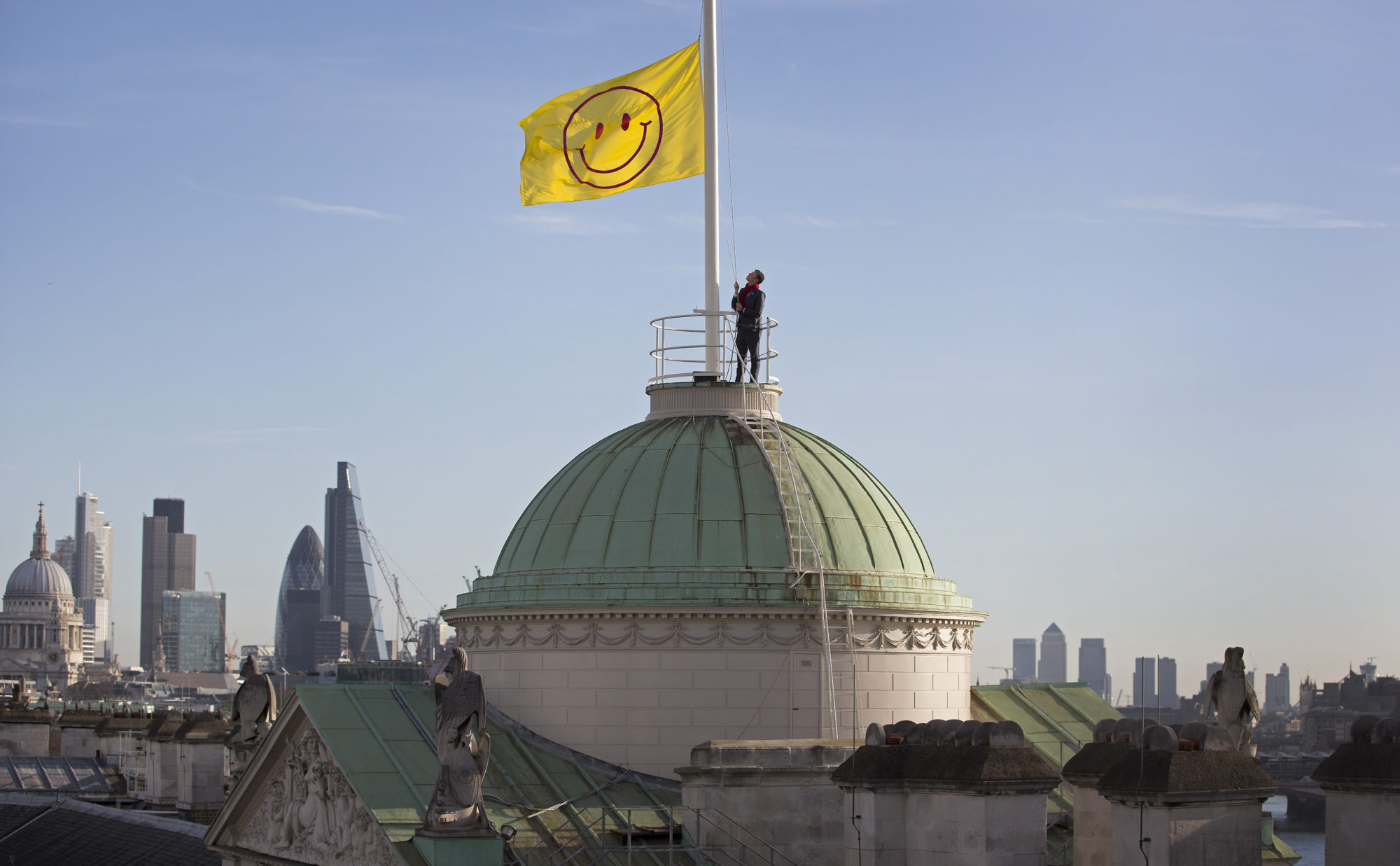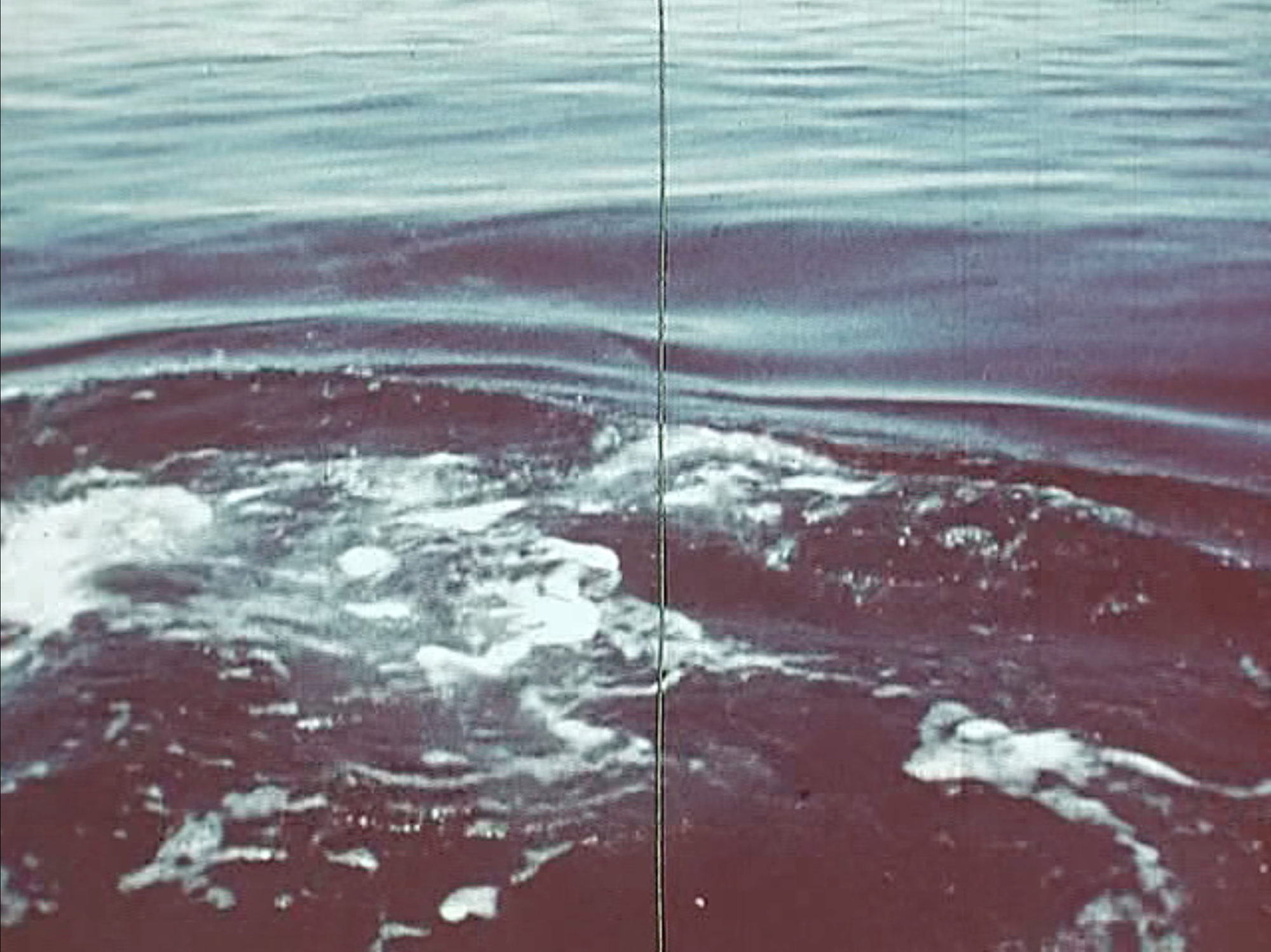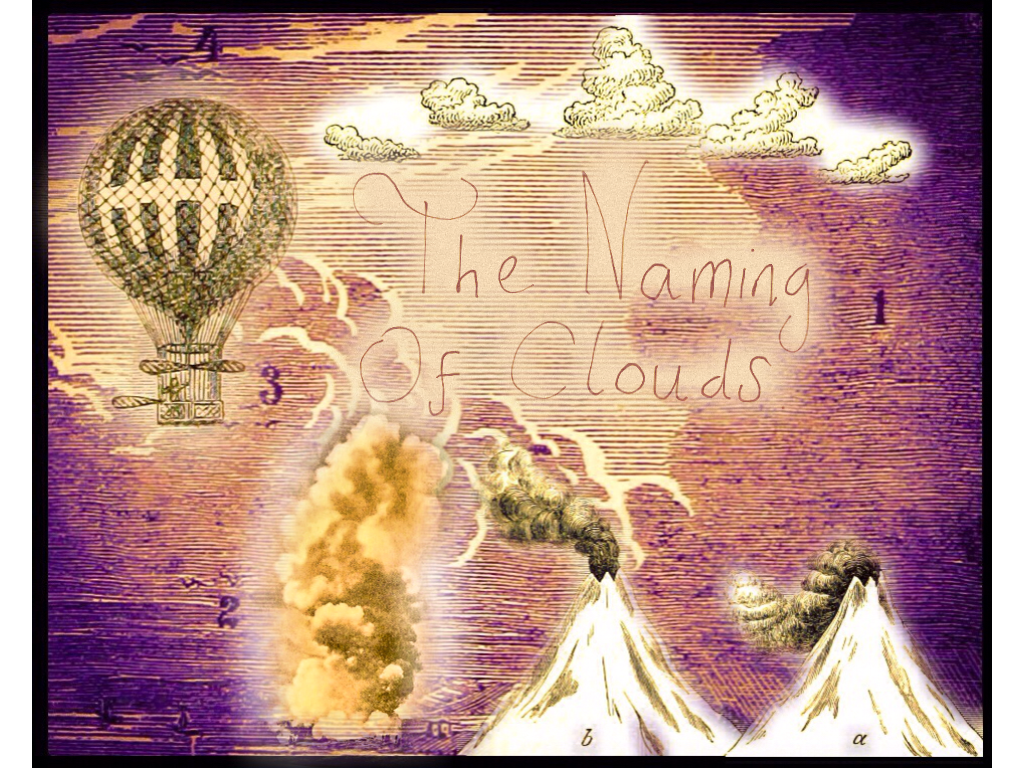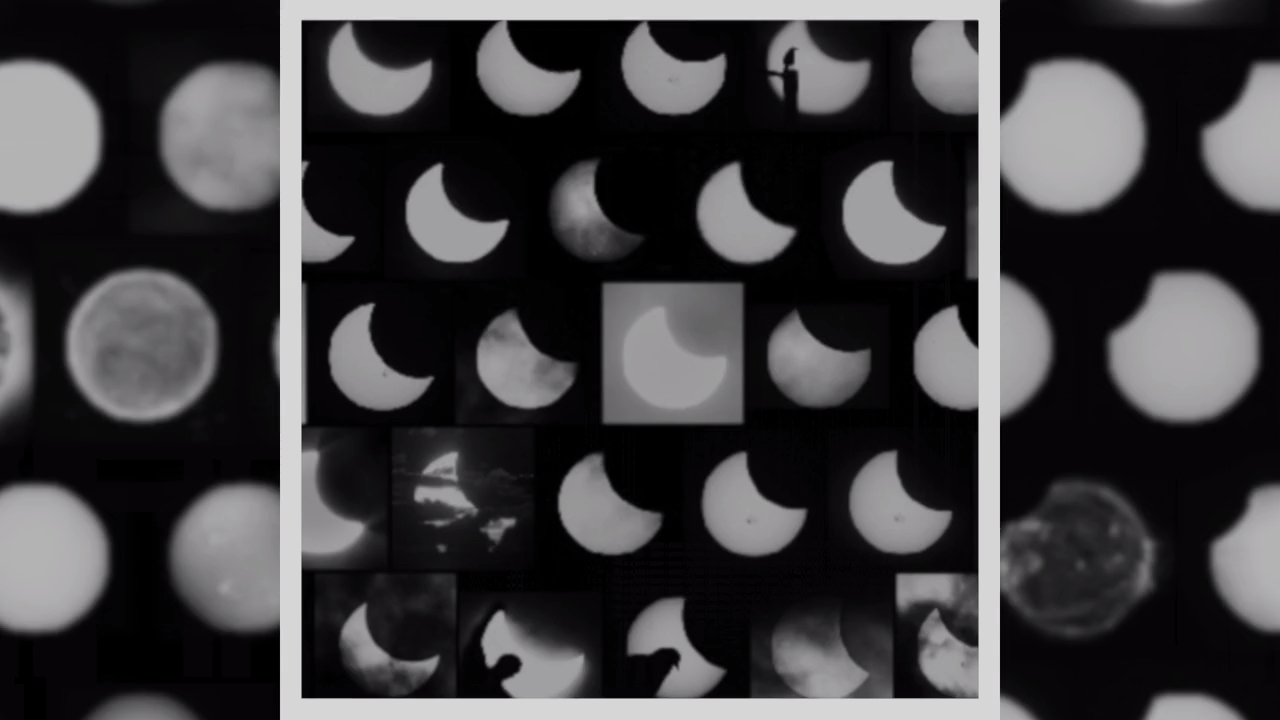Utopia Today

Jeremy Deller and Fraser Muggeridge, Raising the Utopian Flag, 2016 [courtesy of Somerset House]
Share:
Taking place across London this year is UTOPIA 2016, a celebration of the 500th anniversary of the publication of Thomas More’s famous political philosophical fiction. Revolving around central London’s Somerset House, the yearlong series of multi-platform events commemorating this half millennium brings us back to the dawn of political modernity—and provides us with ample time to think through our proximity to the precipice of the modern era. These variations on a theme, explored across disciplines and sites, are brought into sharper focus by a historical look at the departure point itself—More’s Utopia (1516)—as well as its literary antecedents and offspring, and by our subsequent attempts to engineer a model for living in an idealized present day.
Part allegory, part satire, part playful literary exercise, More’s Utopia describes a society that is hard to fathom, yet familiar to us all. The vocabulary of this imagined island community has entered into our everyday language, where its name is used to describe any sociopolitical entity that aims for “perfection,” and its antonym—dystopia—to describe any world turned on its head. The modern, secularized nation-state would not come into being until the 18th century, but Utopia imagined a shared community that was defined not by religion, as was the standard in the 16th century, but by relationship to property: the ownership of slaves was requisite on the island, as was communal living (privacy was frowned upon), and the provision of civil liberties such as universal health care (complete with euthanasia). UTOPIA 2016 explores the relevance of these ideas to contemporary artistic, architectural, and political projects that might be considered utopian or counter-utopian today, and offers a discursive space to think about contemporary utopian predicaments through the paradoxes of More’s imagined community.
More’s original intention for Utopia has remained ambiguous. The book incorporates an epicurean fantasy of liberal living, as well as biting satire of the louche lifestyles of those who dared to renege on its author’s beloved Catholic dogma. The island of Utopia and its customs, manners, civil society, and social organization are described in a level of detail comparable to that of the science of ethnography, which would emerge in Europe almost four centuries later. Concurrent to More’s work, however, was the emerging literary genre of travel writing and exploration reportage, which contributed to the voice of Renaissance humanism and took cues from pre-modern travel writers such as the Greek geographer Pausanias or the late medieval humanist Petrarch. In this early age of discovery, memoirs such as those by John Mandeville and Marco Polo had developed a recognizable genre, through which More could successfully frame his illuminating work of political economy.
Polo and Mandeville’s often hyperbolic narratives were often used as reference points—as prose maps—for subsequent explorations of the New World. These explorers’ literary logs also gave More a recognizable form and structure within which to describe an imaginary society whose differences would illuminate the shifting contexts of European society. Utopia was conceived in a political and religious tinderbox: less than two years after its appearance in print, the Protestant Reformation would catapult Christian Europe into more than a century of war. Following the symbolic beginning of the Reformation in 1517, More, committed to the papacy, ran a campaign against this new movement. Following Henry VIII’s separation from Rome, More was accused of high treason and executed in 1535.
Jessica Sarah Rinland and Philip Hoare, still form We Account the Whale Immortal, 2016 [©Jessica Sarah Rinland and Philip Hoare, courtesy of Somerset House]
Utopia—etymologically formed from the Greek ou (not) and topos (place)—situates the ideal political, religious, and social state in a spatial rather than a temporal dimension: utopia is not “the good old days,” but perpetually in the present of some other “non-place.” In the countless utopian works that have followed More’s, this place of becoming is often aligned with the promises of technology and the role that science might play in mediating human affairs. Francis Bacon’s New Atlantis (1627), for instance, presents a vision of a technocratic society at work, where decisions are made by learned men—scientific high priests—who have harnessed the power of nature. In the last two centuries, the emergence of science fiction as a literary genre has spawned many works in this utopian tradition. Among them are H.G. Wells’ The First Men in the Moon (1901), which charts a lunar society of insect citizens whose professions are predetermined (a roman á clef to the author’s views on educational reform); and the same author’s A Modern Utopia (1905), which imagines a world state governed by mutual customs such as vegetarianism, gender parity, and a straight-edge abhorrence for intoxication. Citizens of this world state were required to spend a week each year drifting alone across some remote part of the world:
For seven consecutive days in the year, at least, each man or woman under the Rule must go right out of all the life of man into some wild and solitary place, must speak to no man or woman, and have no sort of intercourse with mankind. They must go bookless and weaponless, without pen or paper, or money …. They may study maps beforehand to guide them, showing any difficulties and dangers in the journey, but they may not carry such helps.1
Amid the upheaval and ruin that followed the Second World War, Wells’ mandatory annual return to nature was adapted for city life by the Internationale Lettriste, a Paris-based postwar urbanist movement, by the avant-garde COBRA group, and finally by the Situationist International. The dérive (“drift” in French) became the principle expression of psychogeography—a playful yet active way of repossessing the urban environment. Before Guy Debord’s well-known theory of the totality of the spectacle of modern life, Society of the Spectacle (1967), the letterist and situationist groups pursued what they called “unitary urbanism,” an architectural utopianism that focused on the liminal spaces in modern cities that facilitated play and exploration, and that advocated for their integration into new architecture and urban design. This was expressed in Constant Nieuwenhuys’ New Babylon (1956-1974), which its architect thought of not as “a town planning project,” as “a work of art in the traditional sense,” or as “an example of architectonic structure,” but as “a creative game with an imaginary environment.”2
Urbanist and architect Kunlé Adeyemi has recently combined the situationist attraction to play and the future-facing ecology of sci-fi utopianism with sustainable local building techniques to fashion a radical vision of urban living. His Makoko Floating School is a prototype for a waterborne metropolis, located in the swollen heart of Nigeria’s megacity, Lagos. Responding to a booming population and the devastating effects of climate change, Adeyemi’s floating school is the product of collaboration between the local inhabitants of Lagos’ Makoko slums, where precarious and informal houses surround a vast network of seemingly spontaneous canals. The residents and fishing communities that built these networks have been on the verge of eviction since developers began to jostle for lucrative waterfront contracts. Adeyemi’s design manufactures an updated liminal space for play and development in an ultramodern city, with a view to the lived experiences and resilience of communities destabilized by the polarizing flows of globalization.
Jeremy Deller and Fraser Muggeridge, Utopian Flag, 2016 [© Jeremy Deller and Fraser Muggeridge, courtesy of Somerset House]
Although unconnected to UTOPIA 2016, Power and Architecture [June 8-October 9, 2016], an exhibition currently on view at London’s Calvert 22, similarly explores the demarcation of utopian public space, the afterlives of cities conceived in the utopian spirit, and the role these places continue to play in the construction of identities in a post-Soviet world. Power and Architecture reminds us that while the last great redrawing of borders took place upon the collapse of the Soviet Union, more often than not the polities within state lines remain violently contested. The so-called Islamic State of Iraq and the Levant’s offensives against and eventual capture of the cities of Mosul in Iraq and Raqqa in Syria have re-created a condition of urban living that one might characterize as dystopian, a term formed from the Greek for “bad place.” As enacted political projects of idealized conditions of living, Raqqa and Mosul are far removed from More’s Utopia, or from the common usage of the term. Their condition has to do not with the repugnance this and other fundamentalist ideologies inspire, but with the fact that the ideological utopia is not a perpetual present: it is a barely pubescent nostalgia for an unlived “good old days.”
Historically, urban utopian projects have situated themselves in a modern interpretation of an index of religious citations. In Georgian London during the 1790s, a former naval soldier named Richard Brothers claimed to receive a series of revelations that led him to believe he was the prophet of a new Christian religion, as well as the man who was to return the chosen people to Jerusalem and thus initiate the end of days foretold in the New Testament—a reflection of a then popular utopian theory, which still holds currency among a small minority, that the people of Britain are related to one of the 10 lost tribes of Israel. So adamant was he in his belief that he was institutionalized, and he spent the remainder of his life designing the flags, uniforms, urban plans, and buildings of his New Jerusalem. Most spectacular of all was his spatial imagining of a rebuilt holy capital: a true utopia in More’s original etymological construction of a nonplace, rendered without a population, but with countless spaces for them to congregate. Despite Brothers’ obsessive analysis of Biblical texts for hidden meanings, clues, and precedents, his New Jerusalem looked a lot like his own London, with its gardens, palaces, and public architecture directly correlating to building projects he might have seen go up in his own lifetime: the Bank of England, Trafalgar Square, Regent Street, and Marble Arch, to name a handful.
The prototype for Brothers’ Biblical modernity—Georgian London—is an apt setting from which to explore the afterworlds of Utopia. Artists Jeremy Deller and Fraser Muggeridge launched UTOPIA 2016 on January 25 with the raising of a specially commissioned Utopian flag at Somerset House. The pair also created limited-edition copies of More’s text, transliterated into the Utopian language. Anniversary programming includes Visions of Utopia [May 2-September 18, 2016]—an archival display in the Sir John Ritblat Treasures of the British Library Gallery. In the fall, the theme will be embraced by the London Design Biennale [September 7-27, 2016], for which participants from more than 30 countries will present commissions exploring the notion “The World Reimagines the World.” As such, UTOPIA 2016 unites a number of disparate institutions, and it gives them the opportunity for situationist-style play. This fall, King’s College London will continue to host Paths to Utopia, a series of collaborations between artists, architects, technologists, and in-house academics begun in July 2016, accompanied by an “in conversation” series, and aimed at developing a figurative map of today’s utopian vernacular. The program includes an educational experiment on the utopian proposals of 20th-century anarchism, namely that of Ursula K. Le Guin’s novel The Dispossessed: An Ambiguous Utopia (1974); “We Account the Whale Immortal,” a film and performance event that tracks the arrival of three mythic whales in the River Thames; and In Our Hands, an experiential installation of material culture and design from many global traditions, taking its cue from Ernst Bloch’s The Spirit of Utopia (1918), in which the author declares, “Life has been put into our hands.”
Philip Stanier, The Naming of Clouds, 2016 [courtesy of Somerset House]
With the fluidity of mechanical reproduction achieved in the 20th century, cultural utopias floated temporarily away from their religious base and toward the boundless era of automation and artificial intelligence. Futuristic cities, such as those designed by Le Corbusier, stressed human cohabitation with these forms of production. In contrast with a standard of social organization that precludes efficiency, utopian subjects also became subjects of modes of production, to be reproduced within the system they championed and designed and that, inevitably, functions only on the system’s terms. It is at this point that the utopian ideal became inextricable from its dystopian conclusion, fault of a totalitarian logic that has always been integral to the utopia genre. Accordingly, utopian terminology has largely been consigned to the lexical rubbish-heap, where it is seen as a relic of postwar dreams of an enhanced civil society made irrelevant by the Cold War victory of Western neoliberalism over Soviet brutalism. Still, despite a rhetorical shift from the days of Le Corbusier, much new urbanism can be seen as part of the utopian pursuit of this neoliberal system, wherein “sustainability” and “mixed-use development” merely designate embellished forms of normative suburban design.
The mediating aspect of technology and architecture in the utopian imagination returns us to Bacon’s technocratic New Atlantis, and to more recent attempts to destabilize the ways in which the urban environment can be acted upon in a spirit of play and exploration. That utopian ideals have often been specifically correlative to a geographic or political reality affirms the importance of society as a conduit, through human observation of the world and its patterns. In this way, utopian thinking can be seen as profoundly secular, despite the religious frameworks from which it has often emerged. As the political theorist Fredric Jameson has recently bemoaned, “utopia” is palpably absent in the discourse of contemporary life, despite its usefulness as a concept in today’s age of pessimism.3 (More’s island, Jameson suggests, was well named: not a place itself, utopia is a way of situating change within space.)
Katie Paterson’s Totality (2016), a new commission for the Arts Council Collection Somerset House, testified to the power of observation in imagining other worlds within our own. Displayed at UTOPIA 2016’s main site from April 28 to May 22, 2016, the work is a gently rotating mirror ball with a mosaic of small, reflective tiles. The object contains some 10,000 images, dating from 1778 to the present day, documenting solar eclipses through drawings or photography. When reflected on the walls of their small room in Somerset House, the tiles re-create the phases of a solar eclipse, in a kinetic orbit that is both disorienting and deeply consoling. Like the best utopian fictions and designs for life, before Paterson’s immersive environment gives way to the cosmos, it brings us down to earth: a place of potential that is nonetheless in its adolescence—that is, a place replete with the anticipation of an empty school dance, before it’s gotten going.
Katie Paterson, A Mirrorball reflecting every solar eclipse from Earth, 2016 [courtesy of Somerset House]
Timothy P.A. Cooper is an independent programmer, journalist, and researcher whose work is grounded in both anthropology and media history. His writings explore pirated media, its artistic capital, and informal infrastructure, as well as modern visual hierarchies of both aesthetic and anthropological value.



